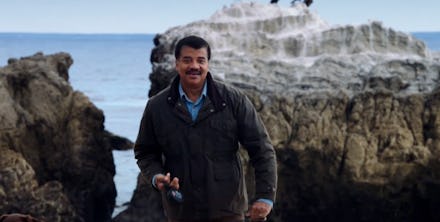The Next Time Someone Says a Blizzard Proves Global Warming Is a Myth, Show Them This

Winter is coming to the East Coast.
Cities across the Northeast are preparing for a potentially historic blizzard that could bury the streets in up to three feet of snow over the next couple of days.
Expect the usual: upheaval in commuting and travel plans, people swarming grocery stores as if a zombie apocalypse were imminent and a flood of climate change deniers coming out the woodwork to claim that one snowstorm proves global warming is a hoax. (Republican Sen. James Inhofe's igloo for Al Gore in 2010 is perhaps the most famous example).
The idea that the world teeters on the brink of catastrophe due to man-made global warming should be a matter of consensus, but it's not. And one of the most frequent and brutish talking points that fuels climate-change denial is the idea that extreme snowstorms shouldn't be happening if the world is growing hotter.
That misconception is based on a major confusion over the difference between the weather and the climate, one that astrophysicist Neil deGrasse Tyson dismantled with one strikingly elegant analogy about walking a dog, expressed in this clip from an episode of Cosmos:
"Weather is what the atmosphere does in the short term, hour to hour, day to day," Tyson says. "Weather is chaotic, which means that even a microscopic disturbance can lead to large-scale changes. That's why those 10-day weather forecasts are useless."
"Climate is the long-term average of the weather over a number of years," he says. "It's shaped by global forces that alter the energy balance in the atmosphere, such as changes in the sun, tilt of the Earth's axis, the amount of sunlight the Earth reflects back to space and the concentration of greenhouse gases in the air. A change in any of them affects the climate in ways that are broadly predictable."
Tyson likens the distinction to the way that dog moves while being walked by a man. The dog's next steps are highly unpredictable, but the range of its wandering is predictable. The key to figuring out its long-term trajectory is to "keep your eye on the man, not the dog."
This is essential to remember when observing phenomena like this week's blizzard, or 2014's polar vortex. Not only are these things possible within a world that's warming, they are in fact more likely to occur within one. Scientists predict extreme weather events will surface across the seasons, and snow is no exception.
"Warming things up means the atmosphere can and does hold more moisture," Kevin Trenberth, a climate scientist at the National Center for Atmospheric Research in Boulder, Colorado, told Mother Jones. "So in winter, when there is still plenty of cold air, there's a risk of bigger snows. With East Coast storms, where the moisture comes from the ocean, which is now warmer, this also applies."
Next time you hear someone complain that harsh winters suggest that global warming is overblown, remind them to observe patterns over time, rather than fixate narrowly on one moment — to keep their eyes on the man, not the dog.